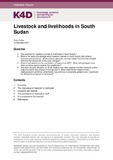| dc.contributor.author | Catley, Andy | |
| dc.coverage.spatial | Sudan | en |
| dc.date.accessioned | 2019-01-04T12:37:13Z | |
| dc.date.available | 2019-01-04T12:37:13Z | |
| dc.date.issued | 2018-12-05 | |
| dc.identifier.citation | Catley, A. (2018). Livestock and livelihoods in South Sudan. K4D Helpdesk Report. Brighton, UK: Institute of Development Studies | en |
| dc.identifier.uri | https://opendocs.ids.ac.uk/opendocs/handle/20.500.12413/14228 | |
| dc.description.abstract | This rapid review provides a synthesis of evaluations and learning reviews of livestock and livelihood in South Sudan. It begins with the elaboration of the importance of livestock to livelihoods. The review identifies that agro-pastoralism is the main livelihood system in rural areas of South Sudan. Although agro-pastoralism involves both livestock rearing and crop production, a household’s financial capital is held in the form of livestock. Additionally, traditional social support systems in South Sudan are based on livestock transactions. Second part of the review discusses the state of knowledge about livestock markets in South Sudan including their drivers, dynamics and structures. The first few years after the Comprehensive Peace Agreement (CPA) in 2005 saw a marked increase in livestock marketing activity in South Sudan associated with oil revenues, rising government employment, and a large influx of returnees. Various agencies collect livestock market information in South Sudan, but an important gap is information on cross-border livestock trade, which is more difficult to measure. The third part of the review focuses on the contribution of livestock to GDP. The most recent official estimate of livestock GDP for South Sudan is US$1.7 billion, but this estimate includes forestry and fisheries. However, using the production method used by the IGAD country studies mentioned above, livestock GDP was later calculated by an IGAD study at US$3.0 billion. Finally, the review elaborates the future directions of agro-pastoralism in South Sudan. In a future, peaceful South Sudan it seems likely that a comparable pattern of market orientation will occur, including more domestic livestock trade as human populations and urban centres grow, and more cross-border trade. This trend will provide economic benefits to those livestock producers who stay in the system, and mobile herding will continue with large herds, sometime cared for by contract herders. However, if South Sudan follows a similar livestock trajectory to other countries, many people will exist on the edge of agro-pastoralism and pastoralism, and mixes of livestock and diversified activities. If so, the main development challenge is to support livestock-based livelihoods where feasible, as well as diversified and alternative livelihoods. | en |
| dc.language.iso | en | en |
| dc.publisher | IDS | en |
| dc.relation.ispartofseries | K4D Helpdesk Report;485 & 508 | |
| dc.rights.uri | https://www.nationalarchives.gov.uk/doc/open-government-licence/version/3/ | en |
| dc.subject | Agriculture | en |
| dc.subject | Economic Development | en |
| dc.subject | Rural Development | en |
| dc.subject | Work and Labour | en |
| dc.title | Livestock and Livelihoods in South Sudan | en |
| dc.type | Other | en |
| dc.rights.holder | © DFID - Crown copyright 2018. | en |
| dcterms.dateAccepted | 2018-12-05 | |
| rioxxterms.funder | Department for International Development, UK Government | en |
| rioxxterms.identifier.project | K4D | en |
| rioxxterms.version | VoR | en |
| rioxxterms.funder.project | 238a9fa4-fe4a-4380-996b-995f33607ba0 | en |

